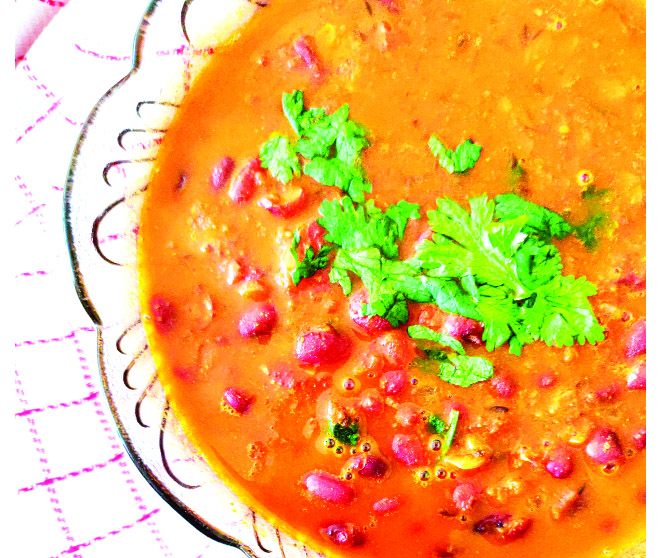Pramiti Digra
Every culture has a love language of its own and for us Indians it has always been food. Our every problem can be diminished with a delicious plate of comfort food. One such heart melting and comforting dish that binds the diverse dialects of flavors of Jammu is Raajmaa or the red kidney bean, a delicacy that every mother whisks up in her kitchen every Sunday.
Food’s delight lies in the belief that we as a culture firmly believe in- that food tastes delicious only when it’s made with the special ingredient called love.
One of my fondest memories are of sitting at the dining table on a Sunday afternoon as everyone makes their plate of Raajmaa Chawal and my mouth salivating as I watch my mother drizzle a spoon full of melted ghee on top of it. Once the plates are made everyone delves into the steaming Raajmaa Chawal with their fingers, jerking and blowing on them unable to wait. Anyone raised in Jammu must have a fond memory of their own featuring Raajmaa as a part of it. However, time flies and all kids grow up and sometime they move out of their home town and that is when it begins- A hunt for Raajmaa that taste of home.
Raajmaa themselves have grown farther away from their homelands over the march of time and are now found in all kinds of shape and sizes. It shares a wild ancestor with its fellow beans that originated somewhere in the Americas. This ancestor spread from what is now northern Mexico to Argentina and was independently domesticated in the Peruvian Andes around 6000 BCE and later in Mexico. The kidney beans left their origin lands and set on a Voyage through history with the arrival of Christopher Columbus in 1492. Over the following centuries, Spanish and Portuguese explorers introduced these New World crops to Europe, and from there, they traveled to Asia and India. French colonizers brought the bean to India in the late 19th century, initially cultivating it in their southern colonies before it spread northward and made its home in our farms and kitchens.
In the Jammu city we have the local Jammu Raajmaa and Bhaderwah rajma, smaller and more aromatic and deeper in colour than other varieties, they also take a lot more time to be cooked completely. In the Dogri cuisine Raajmaa is based with garlic, onions and tomatoes, while the Kashmiris like to add curd into the base which gives it a tangy flavour and when made for a gathering adding just a little bit of Tikki Masala gives it a spicy flair that if found in every Dogri wedding. However, this distinction has been blurred over the time as cultures have traveled from kitchen to kitchen with packed Raajmaa dishes, often sent to friends and families. These days every household is familiar with more than one Raajmaa recipe. As Jammu continues to grow from a town to a city and a smart city so does our mother’s Raajmaa recipes but no matter how you base it the deep red and aromatic curry can’t be achieved with just any variety of Raajmaa.
For those from Jammu who move away, the absence of authentic rajma is deeply felt. The initial excitement of exploring new cuisines often gives way to a longing for the familiar flavors of home. The Jammu and Bhaderwah variety is rarely found in other cities, making it hard to achieve the same taste as home. That’s when a packet or two of local Raajmaa becomes a treasured part of everyone’s luggage when they visit home.As they navigate their way through different cities, the quest for the perfect rajma becomes a culinary adventure. They scour markets for the specific blend of spices, and exchange tips with fellow Jammuites. The first successful attempt at making authentic rajma becomes a rite of passage, celebrated with phone calls home and shared meals with friends who quickly become fans of this cherished dish.
The bachelors living away from home, often thrust into the culinary wilderness, learn and practice their mothers’ recipes. In their tiny kitchens, they discover the magic of replicating the flavors of their childhood. With every attempt, they perfect the balance of spices, the timing of the cooking, and the art of creating that rich, flavorful gravy that defines authentic Jammu rajma. This process of cooking is not just about food; it is a journey of self-discovery. They learn to love and care for themselves, finding solace in the familiar aromas that fill their kitchens, reminiscent of home-cooked meals.
Raajmaa is more than a dish; it is a culinary symbol that binds the diverse cultures of Jammu. It acts as a connecting chain between the locals and those who have moved away. It is a warm reminder of family, and a comforting embrace in a distant land.Whether shared at a family gathering, a community event, or a casual meal with friends, the dish carries with it stories of heritage, tradition, and a sense of belonging.
In the end, Raajmaa brings home to those hunting for its authentic taste. For those who have left Jammu, each bite of home-cooked rajma is a nostalgic journey, a reaffirmation of their cultural identity and being able to cook with that special ingredient named love.


